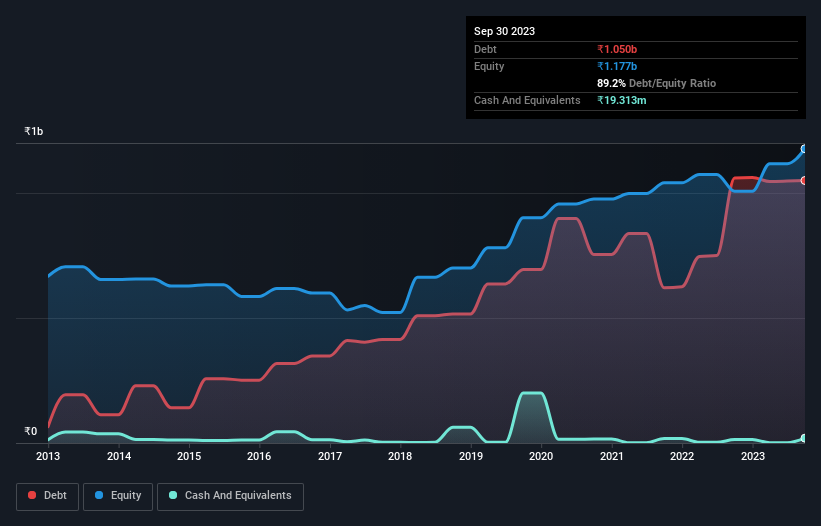The external fund manager backed by Berkshire Hathaway's Charlie Munger, Li Lu, makes no bones about it when he says 'The biggest investment risk is not the volatility of prices, but whether you will suffer a permanent loss of capital.' It's only natural to consider a company's balance sheet when you examine how risky it is, since debt is often involved when a business collapses. As with many other companies Hind Rectifiers Limited (NSE:HIRECT) makes use of debt. But should shareholders be worried about its use of debt?
What Risk Does Debt Bring?
Debt assists a business until the business has trouble paying it off, either with new capital or with free cash flow. If things get really bad, the lenders can take control of the business. However, a more frequent (but still costly) occurrence is where a company must issue shares at bargain-basement prices, permanently diluting shareholders, just to shore up its balance sheet. Of course, the upside of debt is that it often represents cheap capital, especially when it replaces dilution in a company with the ability to reinvest at high rates of return. The first step when considering a company's debt levels is to consider its cash and debt together.
View our latest analysis for Hind Rectifiers
What Is Hind Rectifiers's Net Debt?
The chart below, which you can click on for greater detail, shows that Hind Rectifiers had ₹1.05b in debt in September 2023; about the same as the year before. Net debt is about the same, since the it doesn't have much cash.

How Healthy Is Hind Rectifiers' Balance Sheet?
According to the last reported balance sheet, Hind Rectifiers had liabilities of ₹1.53b due within 12 months, and liabilities of ₹314.2m due beyond 12 months. Offsetting this, it had ₹19.3m in cash and ₹629.3m in receivables that were due within 12 months. So its liabilities total ₹1.20b more than the combination of its cash and short-term receivables.
Of course, Hind Rectifiers has a market capitalization of ₹10.6b, so these liabilities are probably manageable. However, we do think it is worth keeping an eye on its balance sheet strength, as it may change over time.
We use two main ratios to inform us about debt levels relative to earnings. The first is net debt divided by earnings before interest, tax, depreciation, and amortization (EBITDA), while the second is how many times its earnings before interest and tax (EBIT) covers its interest expense (or its interest cover, for short). Thus we consider debt relative to earnings both with and without depreciation and amortization expenses.
While Hind Rectifiers's debt to EBITDA ratio (4.6) suggests that it uses some debt, its interest cover is very weak, at 1.9, suggesting high leverage. So shareholders should probably be aware that interest expenses appear to have really impacted the business lately. The silver lining is that Hind Rectifiers grew its EBIT by 533% last year, which nourishing like the idealism of youth. If it can keep walking that path it will be in a position to shed its debt with relative ease. The balance sheet is clearly the area to focus on when you are analysing debt. But it is Hind Rectifiers's earnings that will influence how the balance sheet holds up in the future. So when considering debt, it's definitely worth looking at the earnings trend. Click here for an interactive snapshot.
Finally, a business needs free cash flow to pay off debt; accounting profits just don't cut it. So we clearly need to look at whether that EBIT is leading to corresponding free cash flow. In the last three years, Hind Rectifiers created free cash flow amounting to 6.4% of its EBIT, an uninspiring performance. That limp level of cash conversion undermines its ability to manage and pay down debt.
Our View
On our analysis Hind Rectifiers's EBIT growth rate should signal that it won't have too much trouble with its debt. However, our other observations weren't so heartening. In particular, interest cover gives us cold feet. Looking at all this data makes us feel a little cautious about Hind Rectifiers's debt levels. While we appreciate debt can enhance returns on equity, we'd suggest that shareholders keep close watch on its debt levels, lest they increase. When analysing debt levels, the balance sheet is the obvious place to start. However, not all investment risk resides within the balance sheet - far from it. These risks can be hard to spot. Every company has them, and we've spotted 4 warning signs for Hind Rectifiers (of which 3 are a bit concerning!) you should know about.
Of course, if you're the type of investor who prefers buying stocks without the burden of debt, then don't hesitate to discover our exclusive list of net cash growth stocks, today.
Valuation is complex, but we're here to simplify it.
Discover if Hind Rectifiers might be undervalued or overvalued with our detailed analysis, featuring fair value estimates, potential risks, dividends, insider trades, and its financial condition.
Access Free AnalysisHave feedback on this article? Concerned about the content? Get in touch with us directly. Alternatively, email editorial-team (at) simplywallst.com.
This article by Simply Wall St is general in nature. We provide commentary based on historical data and analyst forecasts only using an unbiased methodology and our articles are not intended to be financial advice. It does not constitute a recommendation to buy or sell any stock, and does not take account of your objectives, or your financial situation. We aim to bring you long-term focused analysis driven by fundamental data. Note that our analysis may not factor in the latest price-sensitive company announcements or qualitative material. Simply Wall St has no position in any stocks mentioned.
About NSEI:HIRECT
Hind Rectifiers
Designs, develops, manufactures, and markets power semiconductors, power electronic equipment, and railway transportation equipment in India and internationally.
Solid track record with adequate balance sheet.
Market Insights
Community Narratives




